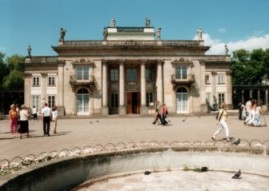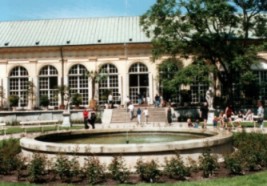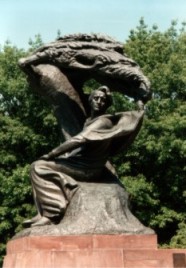 The Royal Łazienki or Warsaw Łazienki (as we have been accustomed to use both these names) is a magnificent historical palace and garden complex now lying in the centre of the city. It has become Warsaw's favourite walking site, and one of the city's main tourist attractions, popular among both Polish and foreign visitors. The final form was given to Łazienki by Poland's last king, Stanislaus Augustus Poniatowski, an outstanding connoisseur of art, who transformed the former Ujazdów Menagerie into his country residence.
The current Łazienki complex encompasses the area stretching under the ancient embankment of the Vistula River, between the streets of Agrykola in the north and Gagarina in the south. Only between the Botanical Garden and the Belvedere Palace, the park reaches westward as far as the avenue of Aleje Ujazdowskie, hence including the sloping and diversified landscape of the embankment. The Royal Łazienki or Warsaw Łazienki (as we have been accustomed to use both these names) is a magnificent historical palace and garden complex now lying in the centre of the city. It has become Warsaw's favourite walking site, and one of the city's main tourist attractions, popular among both Polish and foreign visitors. The final form was given to Łazienki by Poland's last king, Stanislaus Augustus Poniatowski, an outstanding connoisseur of art, who transformed the former Ujazdów Menagerie into his country residence.
The current Łazienki complex encompasses the area stretching under the ancient embankment of the Vistula River, between the streets of Agrykola in the north and Gagarina in the south. Only between the Botanical Garden and the Belvedere Palace, the park reaches westward as far as the avenue of Aleje Ujazdowskie, hence including the sloping and diversified landscape of the embankment. 
The main building of the Łazienki complex is Pałac na Wyspie which translates into English as Palace-on-the-Isle. It is treasured by Poles as one of the most precious masterpieces of art and architecture, and associated predominantly with the artistic undertakings of Poland's last king Stanislaus Augustus Poniatowski.
Another Łazienki building holding a museum exhibition is the Old Orangery. This impressive structure built on a rectangular horse-shoe plan stands at the foot of the embankment. Its main south elevation, divided by pilasters and arcaded windows, is notable for its classical simplicity.  Large windows illuminate an elongated interior intended for orange trees. Two wings adhere to the main body from the north side. The west wing contained quarters for servants and guest rooms, while the east one, considerably wider, housed the theatre. The building, erected between 1786 --1788, Large windows illuminate an elongated interior intended for orange trees. Two wings adhere to the main body from the north side. The west wing contained quarters for servants and guest rooms, while the east one, considerably wider, housed the theatre. The building, erected between 1786 --1788,  was the work of Merlini. The east pavilion, so simple and austere on the outside, hides a richly decorated interior aptly reflecting the sophisticated taste of Stanislaus Augustus. was the work of Merlini. The east pavilion, so simple and austere on the outside, hides a richly decorated interior aptly reflecting the sophisticated taste of Stanislaus Augustus.
The main building of the Łazienki complex is Pałac na Wyspie which translates into English as Palace-on-the-Isle. It is treasured by Poles as one of the most precious masterpieces of art and architecture, and associated predominantly with the artistic undertakings of Poland's last king Stanislaus Augustus Poniatowski.
In 1926, a monument to Fryderyk Chopin was erected on the elevated plateau of the old river embankment. The author of the sculpture was Wacław Szymanowski who won the competition announced for the design of the monument back in 1909. The monument cast in bronze is an Art Nouveau sculpture with unique picturesque expression achieved through the placement of the figure of Chopin under a bronze casting of a willow tree typical for the Polish landscape of the Mazovia region in which Warsaw is situated.
|




 The Royal Łazienki or Warsaw Łazienki (as we have been accustomed to use both these names) is a magnificent historical palace and garden complex now lying in the centre of the city. It has become Warsaw's favourite walking site, and one of the city's main tourist attractions, popular among both Polish and foreign visitors. The final form was given to Łazienki by Poland's last king, Stanislaus Augustus Poniatowski, an outstanding connoisseur of art, who transformed the former Ujazdów Menagerie into his country residence.
The current Łazienki complex encompasses the area stretching under the ancient embankment of the Vistula River, between the streets of Agrykola in the north and Gagarina in the south. Only between the Botanical Garden and the Belvedere Palace, the park reaches westward as far as the avenue of Aleje Ujazdowskie, hence including the sloping and diversified landscape of the embankment.
The Royal Łazienki or Warsaw Łazienki (as we have been accustomed to use both these names) is a magnificent historical palace and garden complex now lying in the centre of the city. It has become Warsaw's favourite walking site, and one of the city's main tourist attractions, popular among both Polish and foreign visitors. The final form was given to Łazienki by Poland's last king, Stanislaus Augustus Poniatowski, an outstanding connoisseur of art, who transformed the former Ujazdów Menagerie into his country residence.
The current Łazienki complex encompasses the area stretching under the ancient embankment of the Vistula River, between the streets of Agrykola in the north and Gagarina in the south. Only between the Botanical Garden and the Belvedere Palace, the park reaches westward as far as the avenue of Aleje Ujazdowskie, hence including the sloping and diversified landscape of the embankment. 
 Large windows illuminate an elongated interior intended for orange trees. Two wings adhere to the main body from the north side. The west wing contained quarters for servants and guest rooms, while the east one, considerably wider, housed the theatre. The building, erected between 1786 --1788,
Large windows illuminate an elongated interior intended for orange trees. Two wings adhere to the main body from the north side. The west wing contained quarters for servants and guest rooms, while the east one, considerably wider, housed the theatre. The building, erected between 1786 --1788,  was the work of Merlini. The east pavilion, so simple and austere on the outside, hides a richly decorated interior aptly reflecting the sophisticated taste of Stanislaus Augustus.
was the work of Merlini. The east pavilion, so simple and austere on the outside, hides a richly decorated interior aptly reflecting the sophisticated taste of Stanislaus Augustus.
